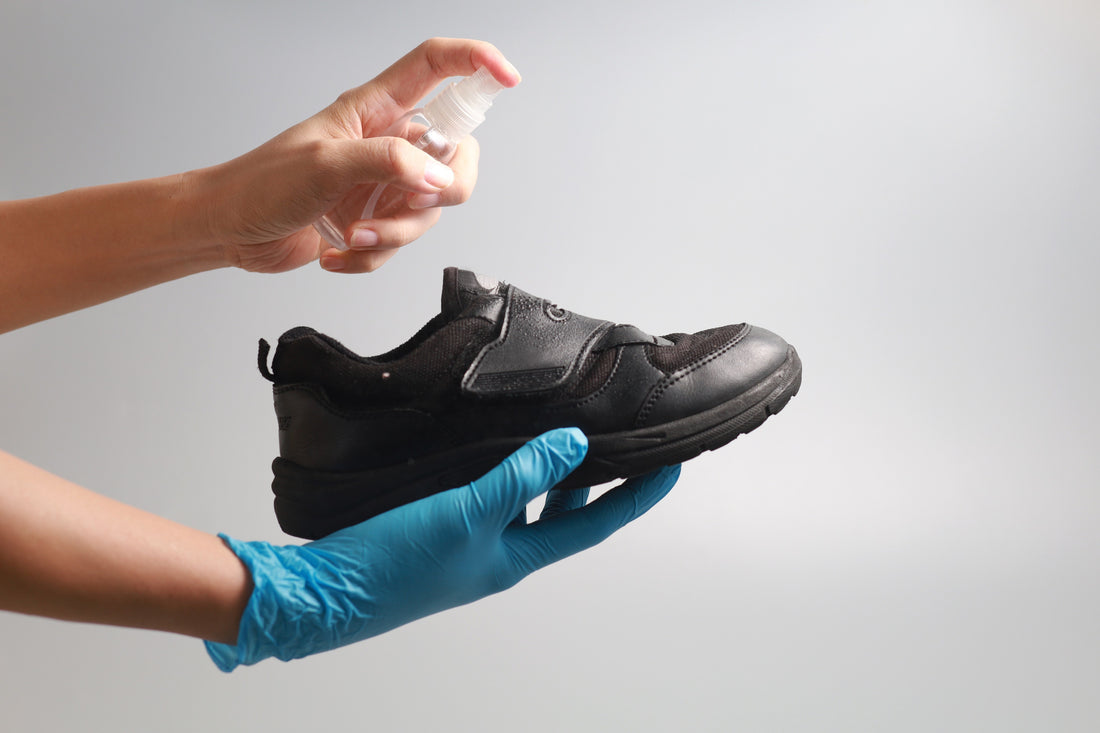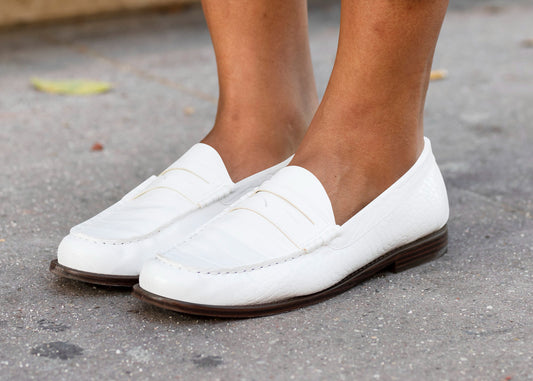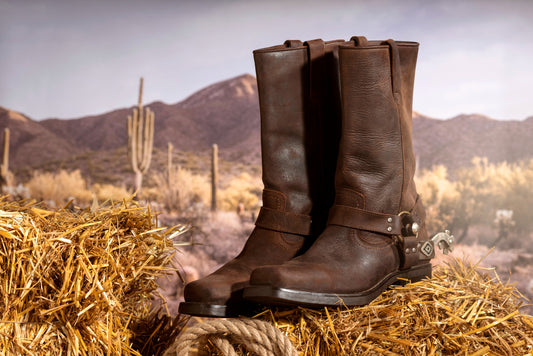Shoe Disinfection 101: Disinfect Shoes the Right Way

One of the most neglected aspects of personal hygiene is the cleanliness of our footwear. Unbeknownst to many, a simple step to disinfect your shoes can significantly reduce the spread of germs. This is especially important for sneaker enthusiasts who often rotate their footwear, potentially spreading bacteria from one pair to another.
Regular shoe cleaning not only prolongs the life of your beloved kicks but also maintains a fresh smell, helping to deodorize them.
So, in the face of potential germ threats, let's stride confidently forward, armed with the knowledge of proper shoe disinfection.
Things You Need to Get Started
- Rubbing Alcohol
- Spray Bottle
- Disinfectant Spray/Deodorizer Spray
- Hydrogen Peroxide
- UV Sanitizers
Rubbing Alcohol

The most basic way to disinfect shoes is by using rubbing alcohol, a common household item that is effective in eliminating odor-causing bacteria and fungus. To sanitize your shoes with rubbing alcohol, you'll need a spray bottle and a clean cloth or wipe.
Here's a simple step-by-step guide:
- First, fill a spray bottle with rubbing alcohol.
- Remove any insoles or inserts from the shoes.
- Spray the inside and outside of the shoes thoroughly, being cautious of the material the shoes are made from. Rubbing alcohol works well on most materials, but for delicate materials, like those found in some dress shoes, a wipe down with a cloth dampened with rubbing alcohol might be a safer option.
- Using a clean cloth or wipe, gently scrub the shoes to ensure the alcohol comes into contact with all areas. Pay special attention to the soles and insides of the shoes where fungus and bacteria are most likely to thrive.
- Allow the shoes to dry completely in a well-ventilated area before wearing them. This step not only ensures the alcohol has time to kill the germs but also prevents any possible discoloration, especially for white shoes.
By following these simple steps, you can successfully sanitize your shoes and tackle shoe odor, all while extending the life of your footwear.
Disinfectant Sprays
Arguably the easiest way to disinfect shoes is to use a product that is specifically designed for this purpose.
Disinfectant sprays, such as the one manufactured by Stone and Clark, target the germs that reside in shoes and work to eliminate them. The spray is especially effective in dealing with fungal organisms that can cause foot infections.
To use the Stone and Clark shoe disinfectant spray, simply shake the can well before spraying it evenly onto your shoes. Be sure to spray from a distance of about six inches, ensuring the entire surface area of the shoes is covered.
Don't forget to disinfect the inside of the shoes as well, as this is where sweat, bacteria, and fungi are most likely to thrive. After application, allow the shoes to dry completely. This disinfectant is designed not to discolor or damage materials, making it safe for all shoe types.
By choosing to use a disinfectant spray, you not only sterilize your shoes but also extend their lifespan, maintaining their look and feel for longer. Remember that consistency is key in preventing the build-up of bacteria and fungi in your shoes, so make sure to disinfect them regularly.
Hydrogen Peroxide
Hydrogen peroxide is another common household item you can use to disinfect your shoes. This solution can be particularly useful when buying secondhand shoes, as it can eliminate the bacteria, fungi, or even virus that may be residing inside of your shoes.
Here's how to do it:
- To begin, remove any loose dirt or debris from the outside of your shoes.
- Next, prepare a solution of equal parts water and hydrogen peroxide.
- Fill a spray bottle with this solution. Alternatively, you could also soak a clean cloth or wipe in the solution.
- Spray or wipe the inside and outside of your shoes thoroughly with the solution. Make sure to pay extra attention to the soles and other areas where dirt and germs tend to accumulate.
- Once you've covered all areas of the shoe, let them air dry in a well-ventilated area. Avoid placing them in direct sunlight as this could potentially damage the shoe material.
If your shoes are washing machine safe, you can also add a cup of hydrogen peroxide to the laundry cycle. This will help disinfect used shoes and remove any stubborn stains or odors.
However, always check the care instructions for your shoes before using this method to ensure it won't cause any damage.
UV Sanitizers
UV shoe sanitizers are another effective tool for disinfecting your shoes. These devices utilize UV light, specifically UVC light, to kill harmful bacteria and fungi within shoes.
Here's how it works:
UVC light has a short wavelength, enabling it to break down the DNA of microorganisms, effectively killing or deactivating them.
UV shoe sanitizers are easy to use - simply insert the device into your shoes, turn it on, and let it work its magic. The process is typically fast, taking only a few minutes to hours depending on the device. Plus, it's a chemical-free, environmentally friendly option for shoe disinfection.
However, be aware that UV light can be harmful to the eyes and skin, so always use UV sanitizers according to the manufacturer's instructions.
Bleach

We're back again to another household item that can disinfect shoes quickly and easily - bleach. Bleach, when combined with detergent and soap and water, can be one of the most effective ways to rid your shoes of bacteria and fungi.
However, it's important to remember to be careful as using bleach can affect the color of your shoes.
Here's a quick guide on how to use it:
- Prepare a solution of one part bleach to five parts water, and add a small amount of mild detergent.
- Dip a clean cloth or sponge into the solution.
- Wipe down your shoes thoroughly, ensuring you cover all areas inside and out.
- Once done, rinse your shoes under cold water to remove any residue.
- Allow your shoes to dry completely in a well-ventilated area before wearing them again.
By following these steps, you can use bleach to disinfect your shoes effectively. Remember, consistency is crucial in maintaining the cleanliness of your shoes, so make sure to perform this cleaning routine regularly.
Bicarbonate of Soda (Baking Soda) and Vinegar

Lastly, if you're dealing with shoes made from materials like leather shoes or suede shoes, you might want to consider using a combination of bicarbonate of soda (baking soda) and vinegar. This method has been used for generations and is known to be very effective.
Here's how you do it:
- Start by removing any loose dirt or debris from your shoes.
- Prepare a solution of equal parts vinegar and water in a spray bottle. For a more pleasant scent, you can opt to spray your shoes with white or apple vinegar.
- Spray the solution onto your shoes, ensuring you cover all areas both inside and out. Be careful not to over-saturate the shoes, as this could damage certain materials.
- After spraying, sprinkle a generous amount of baking soda over the shoes. The baking soda will react with the vinegar to lift the dirt and kill any bacteria or fungi.
- Allow the shoes to sit with the vinegar and baking soda mixture on them for about 15 minutes.
- Using a clean cloth or brush, scrub the shoes gently to remove the baking soda and vinegar mixture along with any dirt or germs.
- Rinse the shoes under cold water to remove any residue. Be careful not to soak the shoes, especially if they are made from delicate materials like leather or suede.
- Finally, pat the shoes dry with a clean towel and then let the shoes air dry in a well-ventilated area. Avoid placing them in direct sunlight or near a heat source, as this could damage the material.
This method is a natural, chemical-free way to disinfect your shoes and remove odors. By following these steps regularly, you can keep your shoes clean and extend their lifespan.
Key Takeaways
Disinfecting your shoes is an integral part of shoe maintenance. It is especially crucial if your shoes are made of materials like suede, which can absorb sweat and odors more than other materials.
To keep your suede shoes clean and fresh, you can use an antibacterial spray specifically designed for such materials. Spray the inside and outside of your shoes thoroughly then allow the shoes to air dry in a well-ventilated spot away from direct sunlight.
While using any kind of disinfectant, it's imperative to refer to the manufacturer's instructions to avoid damaging your shoes.
Following these steps diligently will ensure that your shoes remain bacteria-free and fresh-smelling, prolonging their lifespan.





